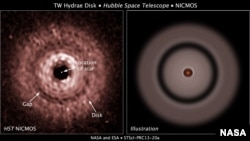What appears to be a planet about 176 light years away from Earth may cause scientists to rethink prevailing theories on how planets are formed.
The potential planet is orbiting the red dwarf star TW Hydrae. According to NASA, it is an astonishing 12 billion kilometers away from its star.
Scientists using NASA’s Hubble Space Telescope spotted a “mysterious gap” in the proto-planetary disk of gas and debris surrounding TW Hydrae. The gap is 3 billion kilometers wide and the disc itself is 66 billion kilometers wide. NASA says gap is likely caused by a “growing, unseen planet that is gravitationally sweeping up material and carving out a lane in the disk, like a snow plow.”
TW Hydrae is a young star at only 8 million years old, and the prevailing theory on planet formation holds that planets take tens of millions of years to form. That this planet is so far from its sun means it would take more than 200 times longer to form than Jupiter because of the distance and the lack of material in the outer parts of the proto-planetary disk. In fact, scientists say that in the area of the suspected planet, there are no large dust grains.
"Typically, you need pebbles before you can have a planet. So, if there is a planet and there is no dust larger than a grain of sand farther out, that would be a huge challenge to traditional planet formation models," said John Debes of the Space Telescope Science Institute in Baltimore, Maryland. Debes is chief of a research team that identified the gap.
According to NASA, this planet may have formed because a part of the disk became gravitationally unstable and collapsed on itself. If true, a planet could form over just a few thousand years.
"If we can actually confirm that there's a planet there, we can connect its characteristics to measurements of the gap properties," Debes said. "That might add to planet formation theories as to how you can actually form a planet very far out."
The planet is estimated to be six to 28 times the mass of Earth, and if it were in our solar system, it would be roughly twice as far as Pluto from our sun.
"It's so intriguing to see a system like this," said Debes. "This is the lowest-mass star for which we've observed a gap so far out."
The team's paper appears online in The Astrophysical Journal.
The potential planet is orbiting the red dwarf star TW Hydrae. According to NASA, it is an astonishing 12 billion kilometers away from its star.
Scientists using NASA’s Hubble Space Telescope spotted a “mysterious gap” in the proto-planetary disk of gas and debris surrounding TW Hydrae. The gap is 3 billion kilometers wide and the disc itself is 66 billion kilometers wide. NASA says gap is likely caused by a “growing, unseen planet that is gravitationally sweeping up material and carving out a lane in the disk, like a snow plow.”
TW Hydrae is a young star at only 8 million years old, and the prevailing theory on planet formation holds that planets take tens of millions of years to form. That this planet is so far from its sun means it would take more than 200 times longer to form than Jupiter because of the distance and the lack of material in the outer parts of the proto-planetary disk. In fact, scientists say that in the area of the suspected planet, there are no large dust grains.
"Typically, you need pebbles before you can have a planet. So, if there is a planet and there is no dust larger than a grain of sand farther out, that would be a huge challenge to traditional planet formation models," said John Debes of the Space Telescope Science Institute in Baltimore, Maryland. Debes is chief of a research team that identified the gap.
According to NASA, this planet may have formed because a part of the disk became gravitationally unstable and collapsed on itself. If true, a planet could form over just a few thousand years.
"If we can actually confirm that there's a planet there, we can connect its characteristics to measurements of the gap properties," Debes said. "That might add to planet formation theories as to how you can actually form a planet very far out."
The planet is estimated to be six to 28 times the mass of Earth, and if it were in our solar system, it would be roughly twice as far as Pluto from our sun.
"It's so intriguing to see a system like this," said Debes. "This is the lowest-mass star for which we've observed a gap so far out."
The team's paper appears online in The Astrophysical Journal.









